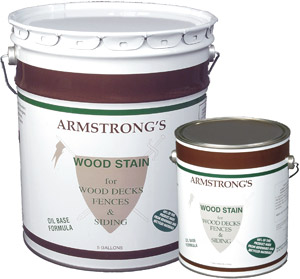
Armstrong Wood Stains
As regulations that lower VOC emissions in stains and other coatings catch on across the country, who could be better prepared to respond than a manufacturer based in California? After all, VOC regulations in the Golden State are among the oldest and toughest in the United States.
As regulations that lower VOC emissions in stains and other coatings catch on across the country, who could be better prepared to respond than a manufacturer based in California? After all, VOC regulations in the Golden State are among the oldest and toughest in the United States.
 The Armstrong-Clark Co. is ready. The company already sells Armstrong Wood Stain that has been retooled to comply with California VOC regulations, and the stain reportedly performs at a level above the first wave of VOC-compliant sealers. The Armstrong-Clark Co. is ready. The company already sells Armstrong Wood Stain that has been retooled to comply with California VOC regulations, and the stain reportedly performs at a level above the first wave of VOC-compliant sealers.
Armstrong-Clark had no choice, says president Jake Clark. “Ninety-five percent of my customers are here in northern California,” he says. “It’s a California deal. We deal with this day in and day out.”
Up until recently, manufacturers that weren’t based in the Golden State could afford to shrug off the issue, Clark points out, because California was practically the only state in the country with VOC caps. “Some of them even debated whether they would deal with California. But we’re Californian. We don’t do it right, we’re out the door.”
Armstrong Wood Stain’s secret is that it is both environmentally friendly and oil-based. It stays wetter longer because its carrier is petrochemical — two nondrying oils — instead of fast-evaporating acetone often found in low-VOC stains.
Before VOC regulations, oil-based stains were 70 percent to 80 percent solvent, Clark says, and the remaining quarter was solids, such as pigments and linseed oil. In low-VOC products, those numbers are reversed, he says. Those are 75 percent solids, 25 percent solvents. As the acetone carrier evaporates, a high-solid stain will quickly form glossy, sticky puddles. These stains often need to be followed with rags or sponges to sop up the gunk that does not have time to soak into the substrate before the acetone is gone. Some must be back-brushed.
Armstrong is different. It sprays on and penetrates overnight, as the two oils keep the stain wet until the solids have soaked into the substrate.
Armstrong can be applied in the heat of the day, even in direct sunlight, without the carrier vaporizing too quickly. The oils even improve the conditioning of dry wood.
The stain is colored with translucent oxide pigments and is sold in clear, transparent, semitransparent and semisolid versions. It contains a mildewcide, water repellants and vegetable oil.

|

